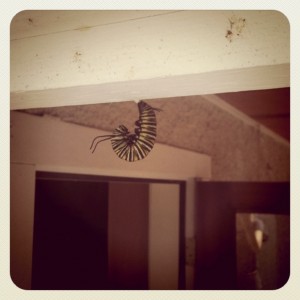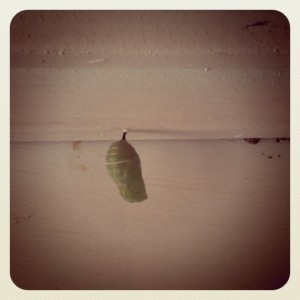Tag: milkweed’
A Very Hungry Caterpillar
- by KitchenPantryScientist
We’ve enjoyed watching the Monarch caterpillar we found a few weeks ago transform from ravenous larva to jewel-like chrysalis. Soon, a beautiful butterfly will emerge and my kids and I will cheer as it soars to the treetops.
It’s a great time of year to find Monarch caterpillars! Look for some milkweed that’s been chewed up and you may find a caterpillar of your own to observe! Be sure to take some milkweed with you and keep it fresh so your caterpillar has plenty of food. The last bunch of caterpillars that hatch out each summer are the ones that make the long trip to Mexico, where they’ll spend the winter before returning to your backyard.
There was a really neat article about Monarchs in the New York Times recently! Click here to read it.
Butterfly Season
- by KitchenPantryScientist
met⋅a⋅mor⋅pho⋅sis
| Biology. a profound change in form from one stage to the next in the life history of an organism, as from the caterpillar to the pupa and from the pupa to the adult butterfly |
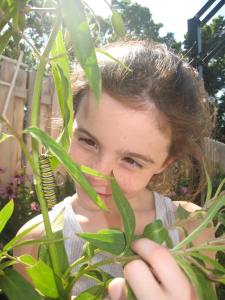
There are few things more magical than watching a caterpillar turn into a chrysalis and then a butterfly. It’s the beginning of butterfly season, and soon you’ll be able to find monarch caterpillars on milkweed. Just this morning, I spotted a Tiger Swallowtail butterfly by the lake. Not only is it fascinating to observe metamorphosis, it is a great opportunity to create some fantastic artwork for your science notebook!
When the weeds in your area start to get big, take a trip to a park, or a farm, or even a weedy lot and search for some milkweed. (See photo below.) Look carefully on the plants, and there’s a good chance you’ll find a Monarch caterpillar like the one my daughter is watching at in the photo at the top of this page. If you find another type of caterpillar, take whatever plant you find it on with you as food. Carefully take the caterpillar and plenty of milkweed and place them in a large see-through container. We used an old plastic pretzel container, but a large jar or Tupperware container would work too. Just be sure to punch air holes! I put the milkweed in a little vase with water to keep it alive, but a friend told me you can put the leaves between damp paper towels and keep them in the fridge, getting them out when you need fresh ones.

milkweed
Last year, I planted butterfly weed, a type of milkweed, in our garden in hopes of getting caterpillars right in our own backyard and it worked! Just plant milkweed or other butterfly-friendly plants this spring and summer if you want a butterfly gardenof your own. It’s a great way to help the butterfly population. Swallowtail caterpillars like dill and I’ve seen caterpillars in my parsley too!
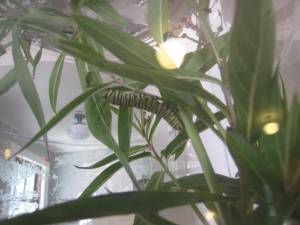
Once you have your caterpillar, all you have to do is make sure it has plenty of leaves to eat. Occasionally, you’ll have to dump out the caterpillar poop, of which there is a surprising amount. Get out your science notebook or just some paper and draw the caterpillar and the milkweed. When it is ready to form a chrysalis, the caterpillar will hang upside down and look like the letter J. Draw the chrysalis, and finally, the beautiful butterfly that emerges! Keep track of how the caterpillar is growing and how long it spends as a crysallis before hatching.
A few years ago, my kids and I were lucky enough to see the caterpillar turn into a chrysalis. It only takes a few seconds and is easy to miss, but it is truely amazing. If you’re lucky and patient, you may see it too. Here is a link to a short video showing what happens.
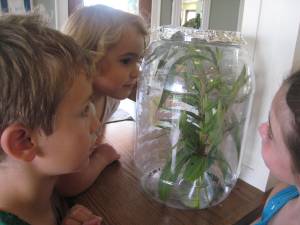
There’s nothing quite like taking the lid off your butterfly house and watching a Monarch soar away into the sky.
